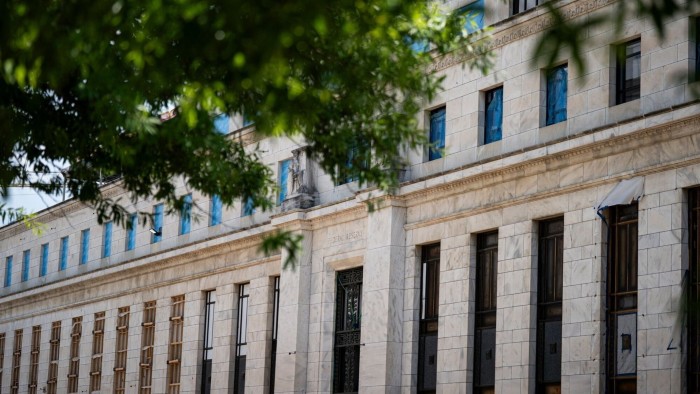Unlock the Editor’s Digest totally free
Roula Khalaf, Editor of the FT, selects her favorite tales on this weekly e-newsletter.
The largest US banks have all handed the Federal Reserve’s annual exams of whether or not they can stand up to a future financial and market disaster, opening the door for them to lift dividends and share buybacks.
The Fed mentioned on Friday that below its “severely adversarial” situation, wherein unemployment surges to 10 per cent, the 22 banks, together with JPMorgan Chase, Goldman Sachs and Financial institution of America, would lose greater than $500bn.
Nonetheless, they’d undergo a a lot smaller hit to capital than lately and stay properly inside required regulatory requirements.
The theoretical recession utilized by the Fed to check banks’ resilience was much less extreme than the earlier yr’s, underlining how regulators have adopted a extra bank-friendly method since Donald Trump gained final yr’s presidential election.
“Massive banks stay properly capitalised and resilient to a spread of extreme outcomes,” mentioned Michelle Bowman, the Fed’s vice-chair for supervision.
The outcomes of the Fed’s “stress exams” will probably be used to calculate the minimal stage of capital that banks want relative to their risk-adjusted belongings, offering a important buffer to soak up losses.
Banks are optimistic that the exams will turn into much more accommodating after the Fed responded to a authorized problem by the primary banking foyer group with a promise to overtake the train. The central financial institution mentioned earlier this yr it deliberate to make the train extra clear and to common the take a look at outcomes over the previous two years to cut back volatility.
The banks are required to attend till Tuesday to supply an replace on what they count on their new capital requirement to be. They often lay out plans for dividends and share buybacks after the Fed stress exams.
The Fed mentioned this yr’s stress exams would push banks’ combination tier one capital ratio, their major cushion towards losses, down by 1.8 share factors — a smaller drop than lately and properly beneath the two.8- percentage-point fall in final yr’s train.
However the Fed mentioned it anticipated to calculate banks’ capital necessities on the idea of its two-year averaging proposal, offering that was finalised within the coming weeks. It will improve the capital hit to 2.3 per cent. Bowman mentioned the change was preferable “to deal with the extreme volatility within the stress take a look at outcomes and corresponding capital necessities”.
The lender with the most important fall in its capital as a result of theoretical stress was Deutsche Financial institution’s US operation, which had a hypothetical decline of greater than 12 per cent, primarily based on the averaged outcomes of the previous two exams. The following largest falls had been on the US subsidiaries of Switzerland’s UBS and Canada’s RBC.
On this yr’s “severely adversarial” situation, US GDP declined 7.8 per cent in a yr, unemployment rose 5.9 share factors to 10 per cent and inflation slowed to 1.3 per cent. Home costs fell 33 per cent and business property costs dropped 30 per cent.
Whereas this is able to be some of the excessive recessions in historical past, it’s milder than the one drawn up by the Fed final yr. The theoretical market crash — with share costs falling 50 per cent and high-yield bonds promoting off sharply — was additionally much less extreme than in final yr’s train.
The Fed mentioned banks benefited from their increased profitability. It added that it had included decrease hypothetical losses from non-public fairness after “adjusting how these exposures are measured to raised align with these exposures’ traits”.
Below strain from Trump to ease the regulatory burden in help of progress and funding, the Fed has introduced plans to remodel lots of its guidelines for banks.
This week, the Fed and the 2 different major banking watchdogs introduced plans to slash the improved supplementary leverage ratio, which units how a lot capital the most important banks have to have towards their complete belongings.

